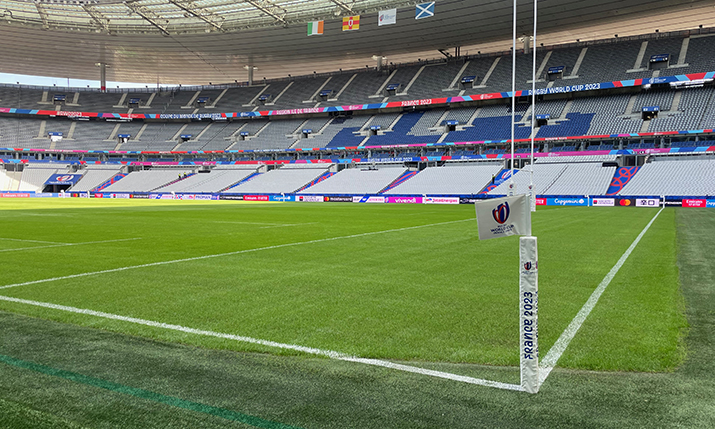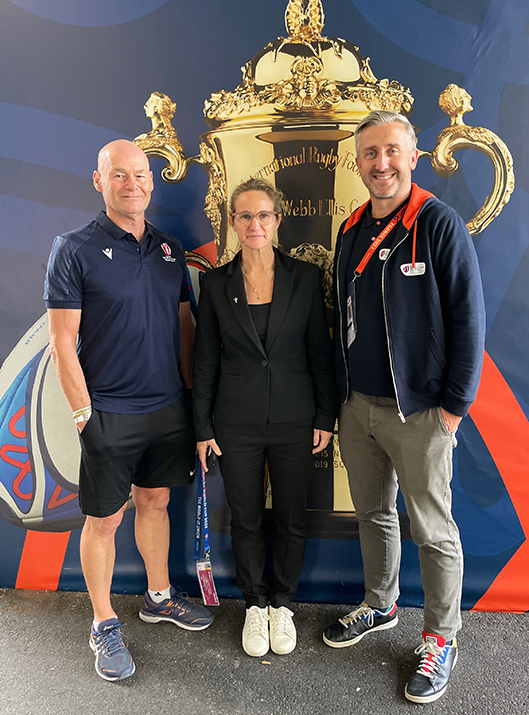Live from the Rugby World Cup 2023: World Rugby and HBS offer up additional content for rights-holding broadcasters

One of the features of Rugby World Cup 2023 is increased rest periods for all teams; for the first time at the Rugby World Cup, no team will have a rest period of fewer than five days. It’s all part of a package of player welfare principles with the aim of aiding recovery from the demands of such an intensely physical sport.
It also means that the tournament stretches to some 71 days, with some pretty sizeable gaps between games. And those gaps, as HBS head of production management Gareth Jones explains, need to be filled with content.
“A week before the tournament started, the amount of content that was on the server from those 12 crews gave everyone a running start and helped those broadcasters who wanted to produce their own previews of those first matches – it’s invaluable to them.”
“We had the opportunity between the last men’s Rugby World Cup in Japan in 2019 and 2023 to look at how we could produce more content for rights holders, and the World Rugby ENG crews – introduced in Japan ¬– were a great way to do that. We had seven in Japan that covered vast areas and tried to get as much interaction with the competing teams, as well as covering the standard press conferences, interviews, and so on.”
And so, the decision was made to increase the number from seven to 12 ENG crews during the pool matches, dropping down to three from the semi-finals onwards.

Left to right: Steve Jamieson, World Rugby executive producer; World Rugby head of broadcast and production Amanda Godson; HBS head of production management Gareth Jones
World Rugby head of broadcast and production Amanda Godson says: “Off the back of Japan, many broadcasters said, ‘It was great that we didn’t have to send a crew, or we didn’t have to send as many crews, because we could utilise your content’. And that’s another reason why we increased the number of the ENG crews in France.”
With 20 teams taking part in the tournament, ENG crews – each crew is comprised of two people, increased to three from the quarter-finals adding a shooting producer – were regionally assigned with the aim of providing broadly equal coverage of the teams.
“For the first time at a RWC, each team has a team base camp, so they have been based in one location for the tournament, which has allowed us to set the ENG crews regionally,” says Godson.
“A week before the tournament started, the amount of content that was on the server from those 12 crews gave everyone a running start and helped those broadcasters who wanted to produce their own previews of those first matches – it’s invaluable to them. The more they can have the better, really. Eventually, it could eventually become a crew-per-team model.”
Popular content
And what do rights holders make of all this extra content? Jones explains that detailed metrics are available on the extent to which rushes have been downloaded. As data about what has proved popular builds during the event analysis can take place to carefully amend editorial plans to better suit usage needs. Further analysis and then post-tournament follow-up conversations with rights holders will take place to find out exactly how the content was used.
Jones also highlights another enhancement to what was provided in Japan. He explains: “In the past, ahead of the start of the tournament we have captured shots of players and managers using green screens, but this time we shot enhanced player profiles of 33 players plus the coach of each team in front of a stylised, LED background shot at a very high frame rate, which produced a lot of good rushes for the broadcaster’s to cut their own promos.
“We also produced a three-second sting of each player, with graphics and a clean version, which has been used in more feed programming to show head-to-heads, but it’s also been used inside the stadiums. All of that’s available on the media server, and they’ve been a real hit and one of the most popular items on the server, because broadcasters can use those throughout the tournament to highlight players within their own packages that they’re producing.”
Post-produced and archived content
In 2019, everything was on-site in Japan, whereas for Rugby World Cup 2023, a remote facility just outside London receives feeds from the IBC at Roland-Garros, enabling it to be used for archiving and logging with content available to rights holders around the world via the ‘TRI’ interface. Stockley Park also houses some 12 edit suites dedicated to Rugby World Cup content, producing the additional content highlights and the preview show programming. “It’s enabled us to provide a lot of consistency and saves real estate here in Paris, and aids our sustainability objectives,” says Jones.
The 2023 Rugby World Cup continues in France until Saturday 28 October.
Read more:
- Live from the Rugby World Cup 2023: Consistency and simplicity are key for host broadcast match coverage
- Live from the Rugby World Cup 2023: Referee mic plays crucial role in capturing atmosphere and ambience
- Live from the Rugby World Cup 2023: Digital content production offering proves popular with broadcasters and ‘TikTok Generation’ alike
- Live from Rugby World Cup 2023: Environmental sustainability underpins all World Rugby and HBS production efforts and decision-making

